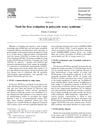Nonalcoholic Fatty Liver Disease and Polycystic Ovary Syndrome
January 2014
in “
World Journal of Gastroenterology
”

TLDR People with PCOS, especially if obese, often have NAFLD, linked to obesity, insulin resistance, and high androgen levels.
The document from 2014 examines the connection between nonalcoholic fatty liver disease (NAFLD) and polycystic ovary syndrome (PCOS), indicating that NAFLD is frequently observed in PCOS patients, with obesity and insulin resistance being major contributing factors. It notes that androgen excess in PCOS may also play a role in the development of NAFLD. The document suggests that PCOS patients, particularly those who are obese, should be screened for NAFLD and that lifestyle changes are the primary recommended treatment, with metformin as a potential pharmacological option. It also discusses the genetic aspects of both conditions, mentioning the PNPLA3 gene variant associated with NAFLD. The document calls for more long-term studies to improve understanding and treatment of NAFLD in PCOS patients, acknowledging that early subclinical atherosclerosis and cardiovascular risks are concerns for these patients. It cites studies showing a high prevalence of NAFLD in PCOS patients, including a retrospective study with 55% of 88 PCOS patients having hepatic steatosis and a prospective case-control study showing a significant difference in hepatic steatosis between PCOS patients and healthy women (41.5% vs 19.4%). The document concludes that hyperandrogenism, along with obesity and insulin resistance, should be considered in the development of NAFLD in PCOS patients.












